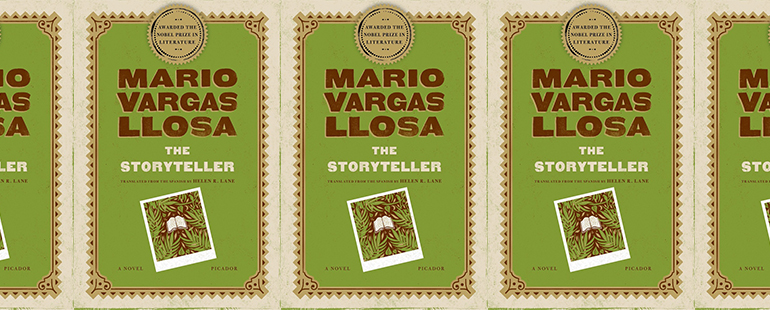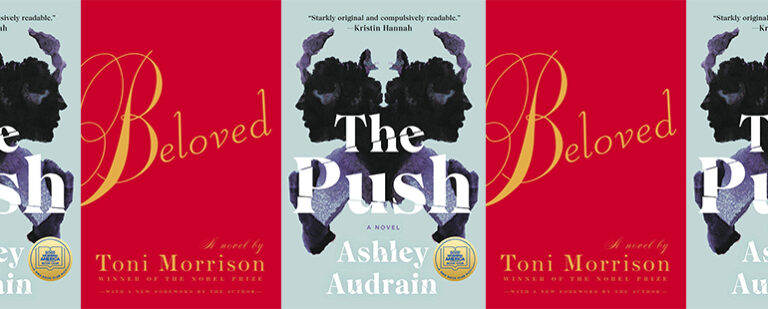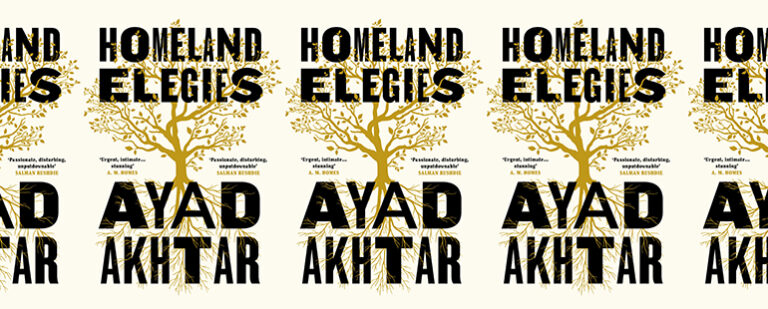Making Men and Myths in Mario Vargas Llosa’s The Storyteller

“We tell ourselves stories in order to live” is an oft-quoted maxim, from Joan Didion’s essay “The White Album,” about the human need to find meaning—the “sermon in the suicide,” as Didion puts it. Stories are a way of ordering events, adding cause to effect, and extracting lessons like drawing sap from a tree so that the world does not seem so chaotic or so cruel. Stories are foundational to society, and as we’ve seen from the vehement opposition by some to Nikole Hannah-Jones’s 1619 Project, challenging a country’s underlying myths is akin to challenging the country itself.
I believe storytelling is also foundational to our concept of ourselves, with personal narratives—those we speak aloud and those we tell to only ourselves—defining the shape of our lives and casting us in various roles as circumstances demand: champion or victim, villain or avenger. I had this idea in mind as I read Mario Vargas Llosa’s novel The Storyteller (originally titled El Hablador, which was first published in Spanish in 1987), about a Peruvian Jew named Saúl Zuratas who leaves his life in Lima behind to live among the Amazonian Machiguenga tribe, and Saúl’s friend, Mario, modeled on the author, who devotes a good chunk of his adult life to attempting to track down Saúl and understand why he would choose this new life.
When Saúl and Mario meet in university, the former is described as having unruly red hair, and a face half-disfigured by a large, wine-colored birthmark. “He was the ugliest lad in the world,” Mario says, though Saúl appears to take it in stride. He tells Mario that people call him Mascarita, or Mask-Face. “Bet you can’t guess why, pal,” he jokes. Saúl is studying anthropology with a focus on the native tribes living around the Amazon, and believes passionately, even religiously, that they should be left alone, that any attempts to modernize them or improve their lives, even attempts to simply study their culture, would cause irrevocable harm to their customs and beliefs. It comes as a shock to Mario, then, when decades later he enters a gallery in Florence to look at an exhibit of photos from his native Peru and sees a red-haired man with a wine-colored birthmark seated before a gathering of rapt Machiguenga tribesmen, telling a story.
From there, the novel moves backward in time, with the mystery of how Saúl got to be a Machiguenga storyteller and why he would choose to abandon all trappings of modern life propelling the story. Through his friendship with Saúl, Mario develops his own interest in the Machiguengas, particularly when he hears of the importance the tribe places upon the storyteller, or hablador—someone whose arrival in a village is cause for tremendous excitement, and whose specific role in society, and very identity, is shrouded in secrecy. Mario tries, over the course of several decades, to learn everything he can about Machiguenga storytellers, and find out what happened to Saúl after he left school and disappeared. In the course of his investigations, readers learn about Peru’s troubled history of exploiting resources belonging to native tribes, and about the various parties who wittingly or unwittingly bring them harm: violent rival tribes, colonists, drug traffickers, rubber plantation owners, and Christian missionaries wishing to add more souls to the fold. Great debates within anthropology are also front and center: how may anthropologists act in the best interests of the people they study, and is the very act of scrutiny a form of violence?
A second narrator is also introduced, a man we eventually come to believe is Saúl, who tells the history of the Machiguenga people, their origins, their beliefs, their customs, their demons and gods, their diet, their explanations for every observable phenomenon, their prohibitions and warnings of evil, as well as numerous digressions into interesting tribesmen he’s met throughout his travels. Saúl speaks in a seemingly directionless way, his stories leaping from history to fable to personal anecdote, all complicated by the fact that, in Machiguenga culture, the one who “breathed out” the Machiguengas was named Tasurinchi, and the name is then used to refer to any man who lives in accordance with the ways of the creator Tasurinchi—which ends up being pretty much every man with whom Saúl comes into contact. Saúl’s stories are not exactly moralizing, but they follow a sort of “just-so” pattern, explaining how the stars in the sky are actually a harem of fireflies, or why the Machiguenga are forbidden from hunting deer. The stories Saúl tells define the parameters of the culture, creating it, expanding it, and cementing it all at the same time. And, readers learn, they also build Saúl’s new identity—both in his own mind and within his new tribe, one word, one story at a time.
Mario speaks of Saúl when he was a university student, and how he had a deep love for Franz Kafka’s The Metamorphosis, “which he had read countless times and virtually knew by heart.” The book’s protagonist, Gregor Samsa, transforms into a “monstrous vermin,” and finds himself alienated from his family and the world by his new physical deformity. Saúl feels commonality with Samsa as he is also trapped inside a body others find appalling, and he repeatedly laments the fate of others like him, particularly babies abandoned and murdered by different cultures for being born imperfect. “They say the Spartans did the same thing, right?” Saúl asks Mario. “That little monsters, Gregor Samsas, were hurled down from the top of Mount Taygetus, right?” He touches his enormous birthmark. “I wouldn’t have passed the test, pal. They’d have liquidated me.”
Saúl is described as jovial and kind—Mario calls him an archangel—but his sadness and loneliness and kinship with the cursed Samsa are palpable both at school and in the jungle as Saúl even hallucinates during an ayahuasca ritual that he has transformed into a detestable “Gregor-Tasurinchi,” a “buzz buzz bug” trapped on his back and ignored by his family. In Saúl’s mind, his story and Samsa’s have overlapped and even merged, and by understanding this key point about Saúl’s own conception of himself, and the stories he tells about himself, we can begin to understand what Mario, despite his investigations and soul-searching, is never quite able to grasp: why Saúl would abandon his life and remake himself with the Machiguengas.
Among the dozens of myths Saúl relates, one he tells late in the novel feels very much as though it is the storyteller’s attempt to explain himself to himself, and to his audience: Inaenka is an evil woman with a bad limp who causes the skin of men to blister and erupt in pain like fire. She comes with her children to a village and destroys several men before her son is summoned by a talking bush and told that he must stop his mother before she brings about the destruction of the earth. The boy does as the bush instructs and leads his mother far away from the village with promises of taking her to a place where her limp will finally be cured. They arrive at a terrible land of monsters, and Inaenka finally sees the ruse. She accepts her fate and says she will stay in the land, but she vows to pursue her son until he, too, is tortured with blisters and pain. “But he did free himself. To escape from Inaenka his soul had to give up its human wrapping; that is what it had to do, and that is what it did. It left his body and started wandering, wandering in search of a refuge, it made its home in that little black bird with white legs. He is now a moritoni.” Saúl seems to see himself as the boy inside the bird, having given up his human wrapping and finding refuge inside the new body of a storyteller. The blistering skin of the men in Inaenka’s path feels appropriate too—by being the keeper of the Machiguenga myths, Saúl can personally see to it that the culture is preserved intact, that meddlesome outside forces, be they scientists or conservationists or missionaries, do not corrupt the ways of the tribe.
The irony, of course, is that Saúl himself has changed the tribe by joining them, and perhaps upset some balance or caused some reaction that could only be appreciated much later. Mario is repeatedly frustrated in his search for answers by the extreme secrecy surrounding the storyteller—who he is and what benefit he provides the others—and he comes to learn that this secrecy is a new feature of Machiguenga culture, and was likely initiated by Saúl himself, requesting that the Machiguengas hide his identity as a safeguard against ever being found out. Do the Machiguengas know Saúl is not one of them? It’s never specified in the text. What makes his stories so special that the society would be willing to alter its customs in order to appease him? Again, we can only guess.
Mario ends the book staring again at the photograph in the gallery in Florence, at a blurry figure he believes, but cannot be certain, is Saúl. In the end, The Storyteller is not Mario’s story but Saúl’s. It is a story about Saúl’s invention of himself, about making men and myths, and about how he creates, expands, and cements himself, Gregor-Tasurinchi, with every word he speaks. He breathes himself into life as Tasurinchi breathed the Machiguengas into life, continuing a tradition as old as stories themselves, and as primal.
This piece was originally posted on Juley 8, 2021.


